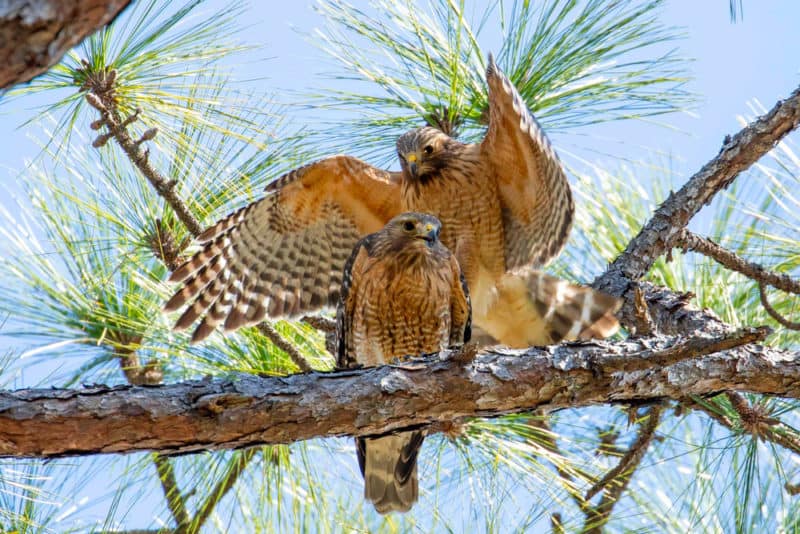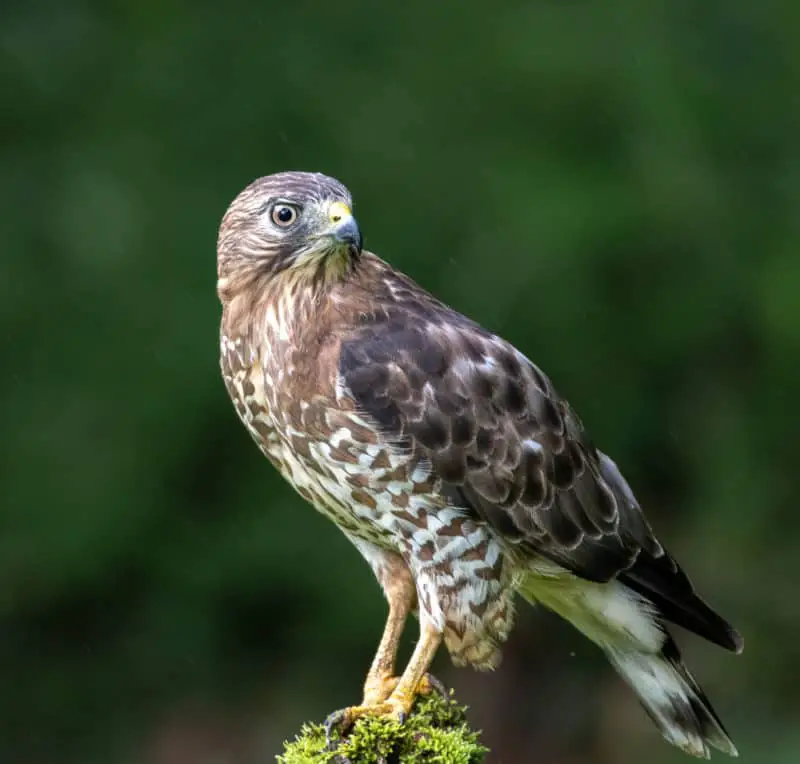Scientific name- “Buteo platypterus“. Common name- Broad-Winged Hawk
The Broad-Winged Hawk is a medium-small, stocky buteo hawk that is common to the woodlands of the eastern United States and Southern Canada.
The population of Broad-winged hawks in North America is upwards of 1,000,000 birds. Ergo, they are one of the more common North American hawks.
One of the Northern Broad-winged hawk’s claims to fame is the large groups they travel in to migrate in the fall and spring. They may well migrate in groups of up to 1,000 birds.
Broad-Winged Hawk Description
The Broad-winged Hawks is one of the smaller buteo hawks. When you view one on a perch, you’ll notice that they have a stocky build and a proportionately large broad head. Adult Broad-Wings range from13 to 17 inches (33 to 43cm) in length. They weigh 9 to 20 ounces (265-560 grams). What’s more, an adult can have a wingspan up to 1 meter (39.37 inches) wide. Source
As with all raptors, their yellow black-tipped bill is hooked to tear apart better the flesh of their prey.
When you view them in flight, you’ll notice that their pointed wings are short and wide in proportion to their body size, giving credence to their common name.
There are light color morph, and dark color morph Broad-winged Hawkes. Light color morph birds have dark brown heads and upper parts while their belly and chest are white with dark barring. Additionally, their tails have alternating broad black and white bands.
Dark morph Broad-Winged Hawks are greyish dark brown all over except their tail. They have white bands on their tail just like light morph birds do.
Broad Winged Hawk Range
Northern Broad-winged hawks are 100% migratory. Their summer breeding range lies in south-central Canada and the eastern half of the United States. However, they spend the winter months in southern Florida and Central and South America. They go as far south as southern Brazil.
In Canada, the summertime breeding grounds for Broad-Winged hawks lies in south-central British Columbia, Alberta, Saskatchewan, Manitoba, Ontario, Quebec, and New Brunswick.
The following U.S states have summertime breeding populations of Broad-Winged Hawkes.
| Alabama | Kentucky | New Hampshire | South Dakota (Eastern |
| Arkansas | Louisiana | New Jersey | Tennessee |
| Connecticut | Maine | New York | Texas (Eastern) |
| Delaware | Maryland | North Carolina | Vermont |
| Florida (Northern) | Massachusetts | North Dakota (Eastern) | Virginia |
| Georgia | Michigan | Ohio | West Virginia |
| Illinois | Minnesota | Oklahoma (Eastern) | Wisconsin |
| Indiana | Mississippi | Pennsylvania | |
| Iowa | Missouri | Rhode Island | |
| Kansas (Eastern) | Nebraska (Eastern) | South Carolina |
There are five more sub-species of a broad-winged hawk in the Caribbean that are permanent residents of their respective ranges. They are non-migratory because the climate is stable between the seasons and their food supply is more constant. Their common names reflect the respective areas that they inhabit. They are as follows.
- The Puerto Rican broad-winged hawk-“Buteo platypterus brunnescens” Native to Puerto Rico
- The Cuban broad-winged hawk-“Buteo platypterus cubanensis” Native to Cuba.
- The Antigua broad-winged hawk-“Buteo platypterus insulicola” Native to Antigua
- The Dominican broad-winged hawk-“Buteo platypterus rivierei” Native to Dominica, Martinique, and St. Lucia
- The Antillean broad-winged hawk-” Buteo platypterus antillarum” Native to the Lesser Antilles. Source
Broad-Winged Hawk Habitat
Broad-winged hawks prefer large deciduous or mixed deciduous and conifer forest habitats. They usually nest near forest clearings or bodies of water. Although they are adaptable, they do best in areas that are far removed from human activity.
In their winter range, they seek out areas similar to their northern habitats. They roost on the edges of tropical forests and cloud forests with mixed deciduous and coniferous growth in central and south America. Some immature birds winter in Florida and the Florida Keys. Source
Broad-Winged Hawk Diet
Broad-winged hawks prey on a variety of animals. They eat small mammals such as squirrels, bats, chipmunks, mice, and voles. They also prey on small to medium-sized forest birds. Additionally, they prey on reptiles such as lizards and snakes, amphibians such as frogs, large insects, and earthworms.
Broad-Winged Hawk Predators
Eggs and nestlings are vulnerable to predators such as raccoons, ravens, crows, great horned owls, and black bears. Additionally, bald eagles, golden eagles, great horned owls, and red-tailed hawks are all capable of and sometimes do kill adult Broad-winged hawks. Source
Broad-Winged Hawk Behavior
Hunting Behavior
Broad-winged hawks are perch hunters. Consequently, they generally wait on a perch beneath the forest canopy where they can survey their surroundings on the ground from concealment. When they spot a prey animal, they silently glide down and snatch it with their talons.
On a more limited basis, these birds will low fly through the woods or along watercourses searching for prey.
After they have captured their quarry, they spend some time preparing certain prey items for consumption. For example, they take the time to skin frogs and snakes and pluck the feathers from birds. On the other hand, they eat most small mammals whole.
These birds rarely need to drink water as they obtain most of the moisture they need from the prey they consume.
Migratory Behavior
Broad-winged hawks are solitary and territorial birds during the breeding season and on their wintering grounds. However, when migration time comes around, they become extremely gregarious. They migrate in large flocks in the hundreds or even the thousands. These migrating groups of Broad-winged hawks are called kettles.
Broad-winged hawk kettles are most extensive during the fall migration to their southern wintering grounds but also occur on a more limited basis in the spring when they travel back to their summertime breeding grounds.

Mating Behavior
Broad-winged hawks become sexually mature in the second breeding season after they are born. During the breeding season, males compete for the right to mate with females through courtship displays that include acrobatic divebombing and cartwheeling flights. Additionally, males sometimes fight one another for the right to breed. Source
They are monogamous during the breeding season, and pairs may stay bonded for multiple years. However, they generally do not mate for life and have different mates in successive breeding seasons.
Mated Broad-winged hawk pairs put on courtship displays where they soar and circle swoop over their nesting area while calling to announce their claim on their territory. While mates locking talons and cartwheeling towards the ground is not as common in Broad-winged hawks as it is in Ferruginous hawks, for example, there is at least one recorded example of broad-wings cartwheeling. Source
They generally build their nests well under the forest canopy. It’s common for them to pick the first crotch in a deciduous tree. Less commonly, they’ll choose a conifer to place their nest in. In this case, they’ll choose a large branch or a platform of branches next to the trunk of the tree.
Their nests consist of dead sticks and twigs from the forest floor. Their nests will measure 12 to 21 inches across and up to 12 inches high. They line the nest cup with bark chips and greenery.
Broad-Winged Hawk Nesting and Life Cycle
Broad-winged hawks typically have a clutch of 1 to 5 eggs that they incubate for a period of 28 to 31 days. The female develops a brood patch and does the vast majority of the incubating. She only leaves the nest to defecate or when the male brings her food. On the other hand, the male does all the hunting. When the male brings food to the female, he will take over the incubation duty while she eats.
When the chicks hatch, they are covered with down and have their eyes open but are otherwise basically helpless. However, they grow and develop rapidly. The female remains at the nest constantly for the first 2 weeks after the chicks hatch. After this point, she will leave the nest for increasingly longer periods to hunt and bring back food along with the male. The chicks will be fledged and able to fly when they are between 5 and 6 weeks old. Source
Broad-winged hawks will be 2 years old when they are old enough to breed, and on average, they have a life expectancy of 12 years in the wild.
Also See
Krebs Creek Outdoors has the following posts on other North American Buteo hawks.
Recent Posts
The only venomous snakes in Washington State are Northern Pacific Rattlesnakes. The Northern Pacific Rattlesnake (Crotalus oreganus oreganus) is a sub-species of the Western Rattlesnake. Anyone...
Skunks are not classified as true hibernators. But they go into a state of torpor when the weather gets cold. Skunks are light sleep hibernators, along with opossums, bears, and raccoons. ...

